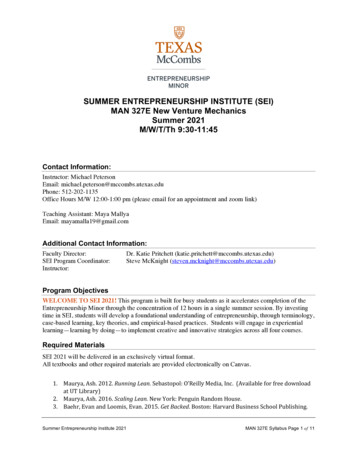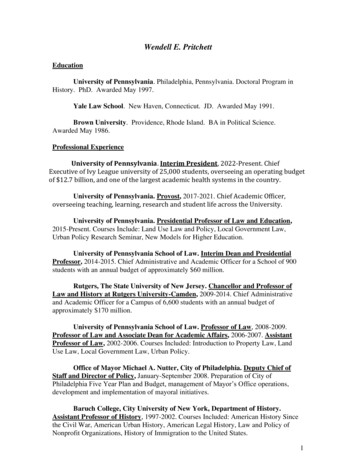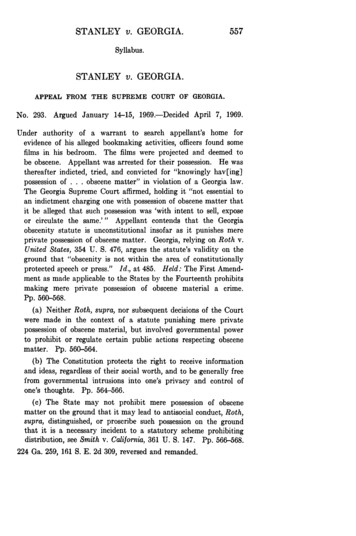
Transcription
Taxes: Price of Civilization or Tributeto Leviathan?Lant Pritchett and Yamini AiyarAbstractThere are two dominant narratives about taxation. One is taxes are the “price we pay for a civilizedsociety” (Oliver Wendell Holmes Jr.). In this view taxes are not a necessary evil (as in the pairing of“death and taxes”) but a positive good as more taxes buy more “civilization.” The other view is thattaxes are “tribute to Leviathan”—a pure involuntary extraction from those engaged in economicproduction to those who control coercive power producing no reciprocal benefit. In this viewtaxes are a bane of the civilized. We consider the question of taxes as price versus tribute forcontemporary India and make three points. First, most discussions of government budgets focuson allocations across sectors and activities and discuss the accounting cost of services provided. Butif the accounting cost exceeds the economic cost (the minimum at which the good or service couldhave been provided) then the difference can be considered “tribute.” Second, the extent to whichgovernment engages in activities which would not have otherwise been carried out at all but whichcitizens value then the “price of civilization” is maximized, but when government budgets produceprivate goods at such low quality they are valued at zero (at whatever accounting cost) then mosttaxpayers consider this tribute. Third, the structure of social spending between “insurance” likeprograms which benefit all individuals at various states or stages of life and sharply targeted transferprograms determines whether most taxpayers consider taxes to fund these expenditures a price ortribute. The notion of a “compulsory purchase” versus “tax” helps elucidate this difference andsharp targeting is seen as raising the price to any given individual of a given degree of individualbenefit. Taken together we argue India needs more taxes as price of civilization but less taxes astribute, which currently dominate. There is a currently a sharp contradiction between the needsfor greater revenue mobilization for India to continue its progress and provide the increasinglysophisticated “civilization” that is demanded with higher productivity and incomes and theperception of the “middle class” that most taxes are tribute. This contradiction is created by a costlyand yet ineffective state the solution to which cannot be a weaker state but a better state.JEL Codes: H2, H21, H71www.cgdev.orgWorking Paper 412August 2015
Taxes: Price of Civilization or Tribute to Leviathan?Lant PritchettHarvard Kennedy School and Senior Fellow, Center forGlobal DevelopmentYamini AiyarAccountability Initiative, Center for Policy Research, NewDelhiCGD is grateful for contributions from the UK Department forInternational Development in support of this work.Yamini Aiyar and Lant Pritchett. 2015. "Taxes: Price of Civilization or Tribute toLeviathan?." CGD Working Paper 415. Washington, DC: Center for Global -price-civilization-or-tribute-leviathanCenter for Global Development2055 L Street NWWashington, DC 20036202.416.4000(f ) 202.416.4050www.cgdev.orgThe Center for Global Development is an independent, nonprofit policyresearch organization dedicated to reducing global poverty and inequalityand to making globalization work for the poor. Use and dissemination ofthis Working Paper is encouraged; however, reproduced copies may not beused for commercial purposes. Further usage is permitted under the termsof the Creative Commons License.The views expressed in CGD Working Papers are those of the authors andshould not be attributed to the board of directors or funders of the Centerfor Global Development.
ContentsTaxes: Price or Tribute? . 1Introduction . 1Higher development is associated with higher, not lower, taxes . 3I.Price or Tribute: Accounting Cost versus Economic Cost . 4A) Accounting cost and Economic Cost: Conceptual. 4B) The “capitalization” of rents . 7C) Empirics from Primary Schooling and Health . 8D) Getting “Benefit Incidence” Completely Wrong . 9II. Price or Tribute: Willingness to Pay . 11A) Example of health care services. 15III. Price or Tribute: Social Insurance and Income Redistribution . 16Conclusion . 18References . 20
Taxes: Price or Tribute?Little else is requisite to carry a state to the highest degree of opulence from the lowest barbarism butpeace, easy taxes, and a tolerable administration of justice: all the rest being brought about by thenatural course of things.Adam SmithIt is shortage of resources, and not inadequate incentives, which limits the pace of economicdevelopment. Indeed the importance of public revenue from the point of view of accelerated economicdevelopment could hardly be exaggerated.Nicholas KaldorIntroductionHistorically many (proto)-states were simply groups that managed to control sufficientmilitary power to force others to pay them tribute. For instance, an armed group could grab aportion of an overland trade route and then demand that all passing pay a tax. This tax waspure tribute as it was simply a forced extraction from the traveler for which the travelerreceived no benefit at all other than safe passage (and the main threat to safe passage wasoften the extractor of tribute). This form of extraction violates all three of Adam Smith’sconditions for opulence as it is neither peace (as the tribute is extracted under threat ofviolence) nor is it an “easy” tax as the payer gets zero benefit, nor does it bring “tolerableadministration of justice” for the payer. We would expect to see tribute—and especially highlevels of tribute—as incompatible with development as it makes politics over the control ofsovereign power simply a contest (often violent) over who controls the extraction andallocation of tribute. In many nation-states taxes (and the extractions from control of naturalresources) are devoted excessively to maintaining a security apparatus and to the distributionof rents among a narrow coalition of elites and patrimonialism. In this case citizens rightlysee taxes as a tribute to be avoided if at all possible and from which they receive little or no“civilization.”But at the same time the richest and most prosperous countries have the highest tax takes as ashare of GDP. Perhaps the main feature of the 20th century has been the creation of nationstates in which the citizens control sovereign power. Colonialism was one form of theextraction of tribute that was eliminated in favor of “national” control of the state.Democracy under rule of law was a means through which states were controlled such thatrather than being regarded as subjects of a sovereign citizens were empowered and thesovereign power of the state was subjected to some modes of expression of the wishes ofthe citizens. Ideally in this situation taxes are the price paid for civilization. That is, citizenschoose the structure of revenues sources (taxes and fees and tolls and contributions andseigniorage etc.) to generate the revenue the government needs to provide peace, a tolerableadministration of justice and whatever else the citizens choose to have the state responsiblefor—from education to roads to health to social transfers to environmental regulation to thepanoply of functions modern states perform. In this context very high levels of taxes (or1
government revenue) are consistent with the “highest levels of opulence” as even very hightaxes can be easy taxes if they are a reasonable price that citizens are collectively willing topay for the civilization they bring (Lindert 2004).In our view the key question for India is how much of the existing extractions of thegovernments (federal and state) are “price of civilization” and how much are “tribute”?Public debate on taxation in India is primarily concerned with India’s tax effort, and theissue of tax administration. Indeed, India has amongst the world’s lowest tax-GDP ratio. In2013-14, India’s total tax revenue (collected by both union and state governments) stood at17.9 percent. And unsurprisingly, public expenditure to GDP ratios too are low especiallywhen compared with other developing countries. In 2013, for instance, India had the secondlowest public expenditure to GDP ratio at 27.1 percent among the emerging economies ofBrazil, Russia, India, Indonesia, China, South Africa and Mexico. Given this low tax effort,the broad public debate has focused on identifying means of improving India’s tax collectionthrough reforms in tax administration. India currently ranks 158 out of 189 in the world onease of paying taxes – such as improving tax administration, reducing tax exemptions andrevenue forgone, introducing the Goods and Services Tax and so on. Debates on taxationhave also focused on concerns related to India’s tax structure in particular the direct-indirecttax ratio. The direct- indirect tax ratio in India in 2012-13 stood at 34.2 percent while theratio was 55.3 in Brazil and 34.4 in China. This high direct –indirect tax ratio is responsibleboth for the creation of complex tax instruments that have resulted in large scale tax evasionamongst the wealthy and a strong sense of horizontal and vertical inequity.We argue that even as these debates on the nuts and bolts of India’s taxation regime gainground, it is important to step back and contextualize the debate on taxation in the broadernarrative of the politics of taxation. In fact, the debate on taxation needs to be situatedwithin the broader narrative of the tensions between the need for greater revenuemobilization and the expansion for public expenditure and state failure to ensure“civilization.” For instance, in the debate about the shift from indirect to direct taxationthere is an element of improving the pure efficiency of the tax collection process so that thetax collected per unit of administrative cost is higher combined with an element that thisreform will also make the tax collections more progressive. But, to the extent that those whowill bear the brunt of additional direct taxation perceived that the public monies are devotedto “tribute” rather than producing greater “civilization”—which civilization in our viewrightly includes socially desirable redistribution to produce a fairer and equitable society andprotect the poor and vulnerable--one can naturally expect resistance to what seems atechnically desirable proposal.While it does fit nearly the ideological left-right spectrum of politics, it is not anincompatible set of views to be simultaneously both pro-tax-as-price-of-civilization and antitax-as-tribute. That is, one can be in favor of paying a reasonable cost for the collectiveprovision of needed goods and services to sustain India as an increasingly sophisticatedeconomy that can productively employ its growing population and provide more reliableneeded services and equitable justice and distribution. But at the same time this does not2
automatically translate into being “pro-tax” as a large part of the existing taxes are simplytribute that generates spoils over which much of contemporary politics is contested (BhanuMehta 2003). Part of the paradox of contemporary India is that it needs more“civilization”—better education, better infrastructure, better administration of justice, bettersocial protection, better health—but that much of the current revenue currently attributed inthe center and state budget to those heads—education, infrastructure, police, socialprotection, health—is pure tribute.An important component of “development” is that taxes-as-price-of-civilization increases asthe state becomes more accountable and effective at providing services and taxes-as-tributedecreases (Pritchett 2009). However, this requires a virtuous circle of citizens engaged in theprocess of demanding value for money (including value for money in redistribution for thepoor and vulnerable). However, once middle class citizens disengage from the utilization ofpublically provided services this can produce a vicious cycle in which the citizens with thepotential to demand accountability disengage leaving an additional burden on the poor tonot only rely on tribute laden publicly produced services but also to devote their limited timeand energies and power to improving governance. This makes it harder to reach the high taxas price-low tax as tribute path to development.Higher development is associated with higher, not lower,taxesFrom Adam Smith’s quote one might assume that “easy taxes” mean “low” taxes and hencethe key to development is to maintain low taxes as part of a laissez faire strategy overall. Butthe assertion that “low” taxes, interpreted as a low tax take to GDP, is a key to developmentis obviously empirically false, both from history and current comparisons. Kaldor (1963) inthe epigram above was right to emphasize the need for public sector revenues to sparkdevelopment.Historically, Lindert’s Growing Public (2004) shows that the trajectory of Europe andthe USA from the onset of modern economic growth around 1870 (or so) is steadyeconomic growth at around 2 percent annum to higher and higher levels of income. Thisgrowth was associated with much, much, higher ratios of total tax to output. The level ofspending associated with social sectors (pensions, unemployment, welfare, health) increasedfrom around 1 percent of GDP around 1900 to a 25 percent of GDP by 2000. In Denmarksocial transfers (non-contributory pensions, health, welfare, unemployment, housing) were1.75 percent of GDP in 1910 and were 28.9 percent in 2000, in France this rise was from .81percent in 1910 to 28.3 percent in 2000. Taxes in France, Germany, Netherlands and the UKincreased from 12 percent to 46% of GDP from 1910 to 2000. In the hundred years from1910 to 2010 total government (federal, state, local) spending the USA went from less than10 percent of GDP to over 40 percent of GDP. Lindert (2004) poses the stark question: iftaxes are bad for economic growth then why did an increase in taxes by factor of three orfour cause no deceleration of economic growth?3
It is also well-known that more “developed” economies—measured either in purelyeconomic terms GDP per capita or economic sophistication or as measures of humandevelopment of any kind—have higher, often much higher, levels of government spendingto GDP than the poorer economies (Besley and Persson 2013). The latest WorldDevelopment Indicators report that in the High Income countries in the Euro Area centralgovernment revenue to GDP is 35.1 percent whereas in low and middle income South Asiait is 11.9 percent (11.8 percent is reported for India) and in low and middle income East Asiathe ratio 12.8 percent. So central government revenue to GDP is at least three times higher inthe rich countries in Europe (and in some countries almost four times—e.g. France 42.7,Netherlands 40.8, Norway 49.5). Of course just “central” government can be a misleadingindicator of revenues or expenditures in federal countries, even in a supposedly “small”government country, the USA, the total of federal, state and local spending is over 40percent of GDP.The tricky question is how can “high” taxes also be “easy” taxes consistent with prosperityand high levels of human development (however measured)—and conversely how can even“low” taxes be “hard” taxes that are an obstacle to development.I.Price or Tribute: Accounting Cost versus Economic CostThe first conceptual point we wish to make is that one cannot determine what of publicexpenditures are “price” and what “tribute” without examining both accounting andeconomic costs. Excess costs of producing government services, particularly when they flowdirectly to rents to specific groups and individuals, are not “price” even if they are attributedin an accounting sense to a desirable good or service. If it costs the government 2.5 times theeconomic cost to produce a year of schooling then this excess cost is conceptually tribute, notprice of civilization.A) Accounting cost and Economic Cost: ConceptualThe word “cost” is used in two fundamentally different ways, which naturally leads toconfusion. The most common use of the word “cost” in discussions of government budgetsis what we will call accounting cost which is descriptive and (mostly) backward looking. Theaccounting cost just adds up all the ex post realized costs attributed in a budget to a givenactivity or project or service or production.Economists use the word “cost” completely differently as “cost” is not a number but afunction. The economic cost is the minimum cost at which a given quantity of a specific good(which includes a specification of the quality) can be obtained.The accounting cost can be decomposed into three components: economic cost, productive inefficiency,and extracted rents.This three-fold distinction is best illustrated with examples.4
Take a year of primary schooling of a given quality (defined by levels of learning).There is an economic cost of that schooling which is the least cost in terms of wage bill,recurrent inputs (e.g. chalk, textbooks) , and capital costs (e.g. depreciation on buildings) forwhich a year of schooling (or, redefined, a year’s worth of learning or education) can beobtained.The accounting cost of a year of schooling could be higher than that for many reasons and wewant to conceptually decompose those into two categories: rents and inefficiency.The definition of an economic rent is a price paid for something over and above the pricenecessary to call that something into existence. So suppose that one could pay a new teacherRs 4,500 per month (inclusive of all wages, benefits, etc) and for that compensation a teacherwould be willing to exert the skills and effort to produce a year’s worth of learning. Nowsuppose that a law required that you pay Rs 25,000 a month for a teacher. This would bepart of the accounting cost of schooling but it would not be part of the economic cost ofschooling, rather it would be an extracted rent paid (in the first instance) to the teacher--thedifference between what a teacher of adequate quality and exerting adequate effort could bepaid and what they by fiat had to be paid. (The teacher may have some or all of this rentextracted so the true “incidence” of the rent is not determined by the fact that it accrues inthe first instance to the teacher). In this simple example the accounting cost is the economic costplus a rent.A different example is the construction of a kilometer of road. Suppose that using somemechanism like an auction one could elicit the information of what the lowest possible cost ofbuilding a kilometer of road (of given quality, in particular location). That cost might turnout to be Rs. 100,000 per kilometer. Now, knowing that one could build the particularstretch of road for Rs. 100,000 per kilometer a bid is accepted to pay someone Rs. 250,000.Then ex-post the accounting cost of the kilometer of road will be Rs. 250,000 which is Rs.100,000 in economic cost and Rs. 150,000 in rent.We want to make the distinction between extracted rent and productive inefficiency. Both of theseare inefficiency in the sense of a gap between the accounting cost and the economic cost. Thedifference is whether the inefficiency benefits (financially or otherwise) increases the wellbeing of the supplier or not. That is, if a road contractor just overcharges for the materialsand labor they provide this is an inefficiency from the point of view of the state as buyer ofthe road but is a direct monetary benefit to the contractor (which they may then share in avariety of ways with political or bureaucratic agents of the state) as an extracted rent. On theother hand if the contractor just, not knowing efficient road production techniques has toomuch wastage of gravel this productive inefficiency benefits neither the state as buyer norcontractor as seller.This three-fold conceptual decomposition applies similarly in the primary school example.The payment of excess wages as extracted rents to teachers is an inefficiency from the point5
of view of the state as buyer but goes directly to the teacher as benefit and is extracted rent. Incontrast, if the teacher is working as hard as they are able but lacks the appropriatepedagogical skills or is attempting to teach an “overambitious curriculum” (Pritchett andBeatty 2012) then this leads to an efficiency as it would, in principle, been possible to getmore education for the given cost but this productive inefficiency did not benefit anyone.Figure 1: Three-fold decomposition of accounting cost into economic cost,productive inefficiency, and extracted rent with examples from primary educationand roadsUnit cost (Rs)Extracted Rent(excess profits ofcontractors)Extracted Rent(excess payments toproviders—higherthan needed wages,less labor provided(e.g. absenteeism))ProductiveInefficiency (e.g. lackof pedagogical skills,poor curriculum)AccountingCostProductiveInefficiency (e.g.wastage, poorconstruction skills)Economic Cost(minimum cost of agiven kilometer ofroad of specifiedquality)Economic Cost(minimum cost of ayear of primaryschool of givenquality)The two sources of excess of accounting cost of public sector production of capital goods(e.g. roads) or services (e.g. education, health) over economic cost “rents” and “productiveinefficiency” have very different politics.The elimination of productive inefficiencies can, potentially, have a “win-win” politics. Thatis, if the source of excess cost is just that producers are unaware of more productivetechniques then training or capacity building or choosing more effective producers could bea boon to taxpayers—by either reducing the taxes paid per service received or increasing the6
services for a given amount of taxes—and is of indifference (or perhaps even a gain) to theproviders/producers.In contrast, the excess of accounting over economic cost that is due to extracted rent, by ourdefinition of extracted rent as an excess cost to the state as buyer that benefits producers, isbound to be a distributive struggle with winners (taxpayers) and losers (rentiers).The best way to think of extracted rents is that these are not a “price of civilization” butrather the opposite, they are pure “tribute” paid by taxpayers to an organized body that hassufficient political power to force the rest of society to pay this tribute.B) The “capitalization” of rentsBefore moving to empirical examples of the potential magnitudes of extracted rents we wantto make the distinction between windfall rents and rents that have been “capitalized.”One illustration of this is water allocations in California. In some parts of California largedams were built that provided water for irrigation. This water, when newly available, wasallocated to certain plots of land. Obviously having irrigation water allocated at a low priceraised the productivity and profitability of that land. The person who owned that land whenit first received the windfall gain (that could reasonably be called a “rent” because the waterwas supplied as a public subsidy priced below long-run average (economic cost) might havereceived some unexpected gain. However the “property right” to the allocation of watertransferred with the property so that the benefit of the subsidy was “capitalized” into thevalue of the land. Hence the next purchaser had to pay the market price for the land whichincluded the valuation of the water rights. Once the subsidies have been “capitalized” therecipient of the subsidy may or may not have ever received any benefit of the subsidy (in thesense of artificially high return on assets or efforts) as some of the subsidy recipients couldhave gotten it as a windfall but others only got it by having to pay for it (and in an efficientland market the full net present value of the additional profitability/productivity of the plotof land due to the subsidy is already incorporated into the price). So the current directrecipient of the subsidy may not be a beneficiary of the subsidy.Take this notion to, say, lower level employees of the government services who are paidsubstantially higher wages than workers with similar qualifications (or even workers doingexactly the same job (perhaps better)) in the private sector). Suppose the government wage is25,000 Rs/month and the private wage is 5,000 Rs/month. Obviously there will besubstantial excess demand for those jobs. Now imagine two allocation rules for those jobs.In one all applicants are placed into a lottery and those that win the lottery get the job. Inthis case winning the lottery is a huge windfall gain to the person who now holds the job. Inanother case some person or persons (illicitly) controls the allocation of the job andessentially auctions the jobs off to the highest bidders. In this case the rent of the excesswage is “capitalized” and the person holding the job and receiving the wage each month isnot a huge beneficiary of the excess wage as the process of getting the job may have forced7
them to pay an amount that made them nearly indifferent between the upfront payment plusaccess to the high monthly wage versus their alternative monthly wage.This capitalization of course can be embedded at higher and higher levels. That is, a givenMinister might have the authority to determine who gets the jobs within his ministry andthere are anticipated to be Q jobs a year, of which it is anticipated will yield price P andhe/she expects to be Minister for N years then he/she might have had to pay someone elseup to P*Q*N to be made Minister. In this case neither the person getting the job nor theperson taking a payment to give the job are the “windfall” beneficiaries of any rents as theyare extracted.C) Empirics from Primary Schooling and HealthPritchett and Aiyar (2014) produce empirical estimates of the gap between accounting costand economic cost for primary education in India using data on public sector costs, privatesector costs and learning outcomes. The basic finding is that in fiscal year 2011 (2011/12)the accounting cost of a year of government schooling was Rs 14,615 while the cost perstudent in private schools (using data on expenditures per child adjusted to FY2011 prices)was Rs 5,961. Even assuming learning were equal (which it wasn’t) and assuming the actualprivate sector cost is “economic cost” (which assumes all schools are productively efficient,which they are not) this implies that the excess of accounting cost over economic cost is Rs50,000 crore (roughly 10 billion dollars).Using differentials in learning from rural areas between private and public schools(unadjusted for selection, so this overstates the pure causal learning differences) and anestimate of the relationship between cost and learning we estimate what it would cost for thepublic sector to reach, at public sector cost structures and efficiency, the private sectorlearning. We do this state by state (as there are large differences across states in both costsand learning gaps) and estimate that the total excess of accounting cost over economic costfor the government to reach existing private school learning levels would be Rs 232,000crores (about 50 billion dollars). This is larger than actual expenditure because at currentexpenditures the learning is lower so much of the cost is the cost of reaching the higherlearning levels.This suggests that much of the government budget on basic education is not a “price ofcivilization” but a “tribute to Leviathan.” In this case the obvious form of tribute is thatteachers in the regular civil service teaching positions are paid at rates enormously higherthan their economic cost—something between 10 and 5 times higher. This is borne out bothby comparisons between public and private but also between the wages paid to civil serviceteachers and to contract teachers in the public sector. And research suggests that there isnothing significant gained in terms of services delivered to taxpayers from these highersalaries as the evidence points out that contract teachers perform at least as well in AndhraPradesh (Muralidaran and Sundararaman 2010). Atherton and Kingdon (2014) find that8
contract teachers in Uttar Pradesh produce twice as much learning per year as similarindividuals made civil service teachers.This implies that between 40 percent (no adjustment for differences in learning quality) and20 percent (adjustment for learning outcomes but no accounting for selection) of the budgetin basic education is “price of civilization” and 60 to 80 percent of the budget is “tribute” inthe form of rents paid through teacher salaries (which, again, may or may not benefitteachers depending on how “capitalized” the wage gains are, that is, how much of the rentthe political system is able to extract from them).There is nothing to suggest that basic education is in any way unique, we focused on thissector principally because it was easier to mea
Center for Global Development 2055 L Street NW Washington, DC 20036 202.416.4000 (f) 202.416.4050 www.cgdev.org The Center for Global Development is an independent, nonprofit policy research organization dedicated to reducing global poverty and inequality and to making globalization work for the poor. Use and dissemination of










